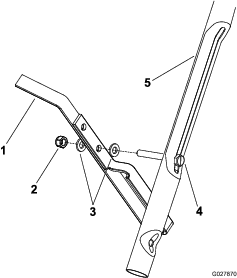| Maintenance Service Interval | Maintenance Procedure |
|---|---|
| Before each use or daily |
|
Introduction
Read this information carefully to learn how to operate and maintain your product properly and to avoid injury and product damage. You are responsible for operating the product properly and safely. Keep this manual for future reference.
You may contact Toro directly at www.Toro.com for product safety and operation training materials, accessory information, help finding a dealer, or to register your product.
Whenever you need service, genuine Toro parts, or additional information, contact an Authorized Service Dealer or Toro Customer Service and have the model and serial numbers of your product ready. Figure 1 identifies the location of the model and serial numbers on the product.
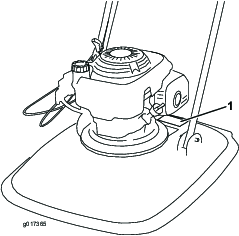
Write the product model and serial numbers in the space below:
This manual identifies potential hazards and has safety messages identified by the safety-alert symbol (Figure 2), which signals a hazard that may cause serious injury or death if you do not follow the recommended precautions.

This manual uses 2 words to highlight information. Important calls attention to special mechanical information and Note emphasizes general information worthy of special attention.
This product complies with all relevant European directives. For details, see the separate product specific Declaration of Conformity (DOC) sheet.
Net Torque: The gross or net torque of this engine was laboratory rated by the engine manufacturer in accordance with the Society of Automotive Engineers (SAE) J1349. As configured to meet safety, emission, and operating requirements, the actual engine torque on this class of machine will be significantly lower. Go to www.Toro.com to view specifications on your machine model.
Do not tamper with the engine controls or alter the governor speed; doing so may create an unsafe condition resulting in personal injury.
Safety
The following safety section is adapted from ANSI B71.4–2012 and EN 14910.
General Safety
This product is capable of injuring hands and feet and of throwing objects. Always follow all safety instructions to avoid serious personal injury.
Using this product for purposes other than its intended use could prove dangerous to you and bystanders.
-
Read and understand the contents of this Operator’s Manual before starting the engine.
-
Do not put your hands or feet near moving components of the machine.
-
Do not operate the machine without all guards and other safety protective devices in place and working on the machine.
-
Keep clear of any discharge opening. Keep bystanders a safe distance away from the machine.
-
Keep children out of the operating area. Never allow children to operate the machine.
-
Stop the machine and shut off the engine before servicing, fueling, or unclogging the machine.
Improperly using or maintaining this machine can result in injury. To reduce the potential for injury, comply with these safety instructions and always pay attention to the safety-alert symbol, which means Caution, Warning, or Danger—personal safety instruction. Failure to comply with these instructions may result in personal injury or death.
You can find additional items of safety information in their respective sections throughout this manual.
Before Operation Safety
General Safety
-
Become familiar with the safe operation of the equipment, operator controls, and safety signs.
-
Check that all guards and safety devices are in place and working properly.
-
Always inspect the machine to ensure that the cutting unit bolt, line, and disc are not worn or damaged.
-
Inspect the area where you will use the machine and remove all objects that the machine could throw.
-
Adjusting the cutting height may bring you into contact with the moving cutting disc, causing injury.
-
Shut off the engine and wait for all moving parts to stop.
-
Disconnect the spark-plug wire from the spark plug before adjusting the cutting height.
-
Fuel Safety
Danger
Fuel is extremely flammable and highly explosive. A fire or explosion from fuel can burn you and others and can damage property.
-
To prevent a static charge from igniting the fuel, place the container and/or machine directly on the ground before filling, not in a vehicle or on an object.
-
Fill the fuel tank outdoors, in an open area, when the engine is cold. Wipe up any fuel that spills.
-
Do not handle fuel when smoking or around an open flame or sparks.
-
Store fuel in an approved container and keep it out of the reach of children.
Warning
Fuel is harmful or fatal if swallowed. Long-term exposure to vapors can cause serious injury and illness.
-
Avoid prolonged breathing of vapors.
-
Keep your hands and face away from the nozzle and the fuel-tank opening.
-
Keep fuel away from your eyes and skin.
During Operating Safety
General Safety
-
Wear appropriate clothing, including eye protection; slip-resistant, substantial footwear; and hearing protection. Tie back long hair and do not wear jewelry.
-
Do not operate the machine while ill, tired, or under the influence of alcohol or drugs.
-
The cutting unit is sharp; contacting the disc or line can result in personal injury. Shut off the engine and wait for all moving parts to stop before leaving the operating position.
-
When you release the operator-presence control, the engine should shut off and the cutting unit should stop within 3 seconds. If not, stop using your machine immediately and contact an Authorized Service Dealer.
-
Operate the machine only in good visibility and appropriate weather conditions. Do not operate the machine when there is the risk of lighting.
-
Wet grass or leaves can cause serious injury if you slip and contact the cutting unit. Mow only in dry conditions, if possible.
-
Use extreme care when approaching blind corners, shrubs, trees, or other objects that may block your view.
-
Watch for holes, ruts, bumps, rocks, or other hidden objects. Uneven terrain could cause a slip-and-fall accident.
-
Stop the machine and inspect the cutting unit after striking an object or if there is an abnormal vibration in the machine. Make all necessary repairs before resuming operation.
-
Before leaving the operating position, shut off the engine and wait for all moving parts to stop.
-
If the engine has been running the muffler will be hot and can severely burn you. Keep away from the hot muffler.
-
Use accessories and attachments approved by The Toro® Company only.
Slope Safety
Warning
Running the engine on slopes of more than 45 degrees will cause severe engine damage due to a lack of lubrication. Some of the potential damage could include stuck valves, scored pistons, or burned crank bearings.
-
Before operating on any slope, a site survey should be completed to determine the actual slope where the unit will be operating.
-
Do not run the 4-cycle Honda engine in this product on slopes of more than 45 degrees.
-
Avoid mowing wet grass. Poor footing could cause a slip-and-fall accident.
-
Mow with caution near drop-offs, ditches, or embankments.
-
When using the machine, always keep both hands on the handlebar.
-
When cutting from the top of a steep slope and you need longer reach, use an approved extended handlebar if you need a longer reach.
After Operating Safety
General Safety
-
Clean grass and debris from the machine to help prevent fires. Clean up oil or fuel spills.
-
Allow the engine to cool before storing the machine in any enclosure.
-
Never store the machine or fuel container where there is an open flame, spark, or pilot light, such as on a water heater or on other appliances.
Hauling Safety
-
Use care when loading or unloading the machine.
-
Secure the machine.
-
The engine is not to be used to lift the machine, as sharp edges could cause injury.
Maintenance Safety
-
Disconnect the spark-plug wire from the spark plug before performing any maintenance procedure.
-
Wear gloves and eye protection when servicing the machine.
-
Wear gloves when servicing the cutting unit.
-
Never tamper with safety devices. Check their proper operation regularly.
-
Tipping the machine may cause the fuel to leak. Fuel is flammable and explosive, and can cause personal injury. Run the engine dry to remove the fuel with a hand pump; never siphon the fuel.
Safety and Instructional Decals
Important: Safety decals and instructions are easily visible to the operator and are located near any area of potential danger. Replace any decal that is damaged or missing.
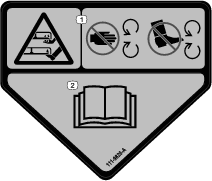

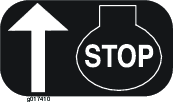
Setup
Assembling the Handle
-
Slide 2 bushings into the frame.
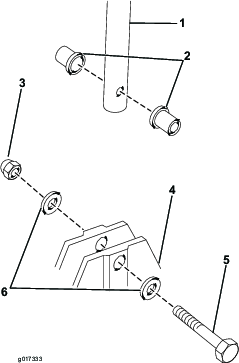
-
Place the lower handle between the bushings and secure it with 1 handlebar bolt, 2 washers, and 1 nut.
Note: Place the lower handle between the bushings with the kick stop assembly at the right side.
-
Repeat for the opposite side.
-
Align the holes on the upper handle with the lower handle.
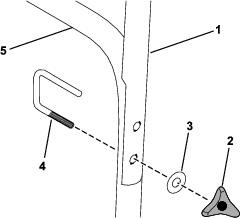
-
Fit the U-bolt through the upper and lower handle and secure it with a washer and a hand wheel.
-
Attach the throttle assembly to the outside of the handlebar and secure it with a nut and a pan screw.
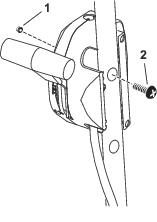
Installing the Footstop
Filling the Engine with Oil
Important: Your machine does not come with oil in the engine. Before starting the engine, fill the engine with oil.
Max. fill: 0.59 L (20 fl oz), type: Multigrade Mineral 10W-30 oil with an API service classification of SF, SG, SH, SJ, SL, or higher.
-
Move the machine to a level surface.
-
Remove the dipstick (Figure 7).
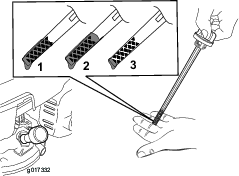
-
Slowly pour oil into the oil-fill hole, wait 3 minutes, and check the oil level on the dipstick by wiping the dipstick clean and then inserting, but not screwing in, the oil-fill cap into the hole (Figure 8).
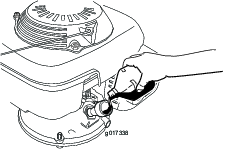
Note: Fill the engine crankcase with oil until the dipstick indicates that the engine-oil level is correct as shown in Figure 7. If you overfill the engine with oil, remove the excess oil as directed in Changing the Engine Oil.
-
Install the dipstick and hand tighten it securely.
Important: Change the engine oil after the first 5 operating hours; change it yearly thereafter. Refer toChanging the Engine Oil.
Product Overview
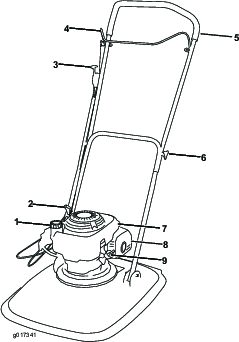
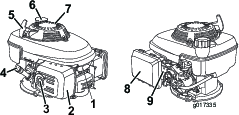
| Model | Cutting width | Product width |
| 02612 | 457 mm (18 inches) | 574 mm (22 5/8 inches) |
Operation
Filling the Fuel Tank
-
For best results, use only clean, fresh, unleaded gasoline with an octane rating of 87 or higher ((R+M)/2 rating method).
-
Oxygenated fuel with up to 10% ethanol or 15% MTBE by volume is acceptable.
-
Do not use ethanol blends of gasoline, such as E15 or E85, with more than 10% ethanol by volume. Performance problems and/or engine damage may result, which may not be covered under warranty.
-
Do not use gasoline containing methanol.
-
Do not store fuel either in the fuel tank or in fuel containers over the winter unless fuel stabilizer has been added to the fuel.
-
Do not add oil to gasoline.
Fill the fuel tank with fresh unleaded regular gasoline from a major name-brand service station (Figure 11).
Important: To reduce starting problems, add fuel stabilizer to the fuel all season, mixing it with fuel less than 30 days old.
Refer to your engine owner’s manual for additional information.

Checking the Engine-Oil Level
-
Move the machine to a level surface.
-
Remove the dipstick and wipe it with a clean cloth.
-
Insert, but do not screw in, the dipstick into the oil-fill hole.
-
Remove the dipstick and check it.
-
To determine the proper oil level on the dipstick, refer to Figure 12).

-
If the oil level is low, slowly pour oil into the oil-fill hole, wait 3 minutes, and check the oil level on the dipstick by wiping the dipstick clean and then inserting, but not screwing in, the oil-fill cap into the hole.
Note: Max. fill: 0.59 L (20 fl oz) Multigrade Mineral 10W-30 oil with an API service classification of SF, SG, SH, SJ, SL, or higher.
Note: Fill the engine crankcase with oil until the dipstick indicates that the engine-oil level is correct as shown in Figure 12. If you overfill the engine with oil, remove the excess oil as directed in Changing the Engine Oil.
-
Install the dipstick and hand tighten it securely.
Important: Change the engine oil after the first 5 operating hours; change it yearly thereafter. Refer to Changing the Engine Oil.
Adjusting the Cutting Height
Warning
Adjusting the cutting height may bring you into contact with moving parts, causing serious injury.
-
Stop the engine and wait for all moving parts to stop.
-
Wear gloves while handling the cutting unit.
Caution
If the engine has been running, the muffler will be hot and can severely burn you. Keep away from the hot muffler.
Adjust the cutting height as desired.
-
Turn the fuel switch to the Off position.
-
Disconnect the wire from the spark plug.
-
Tip the machine on its side, with the dipstick down.
-
Wearing protective gloves, remove the retaining bolt and cutting disc.
-
Reposition the spacers to the desired height, then reinstall the cutting disc (Figure 13).
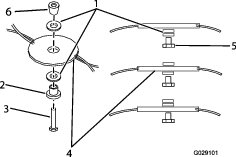
Note: The large spacer must be positioned directly below the impeller at all times.
-
Use a torque wrench to tighten the bolt to 25 N∙m (18 ft-lb).
Starting the Engine
-
Place the throttle control to the CHOKE position, ensure that the fuel switch is in the ON position.
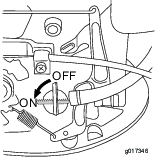
-
Hold the operator-presence control against the handle.
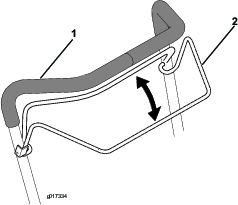
-
Place your foot on the deck and tilt the machine toward you (Figure 16).
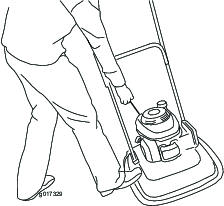
-
Pull the recoil-start handle.
Note: If the machine does not start after several attempts, contact an Authorized Service Dealer.
Adjusting the Choke
Use the throttle assembly to adjust the choke (Figure 17).
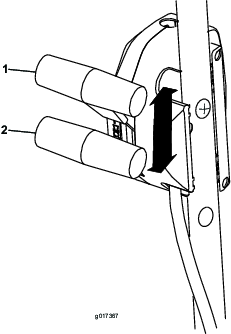
Shutting Off the Engine
| Maintenance Service Interval | Maintenance Procedure |
|---|---|
| Before each use or daily |
|
To shut off the engine, release the operator-presence control (Figure 18).
Important: When you release the operator-presence control, both the engine and cutting disc should stop within 3 seconds. If they do not stop properly, stop using your machine immediately and contact an Authorized Service Dealer.
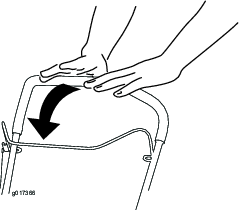
Operating Tips
General Mowing Tips
-
Inspect the area where you will use the machine and remove all objects that the machine could throw.
-
Avoid striking solid objects with the cutting line. Never deliberately mow over any object.
-
If the machine strikes an object or starts to vibrate, immediately shut off the engine, disconnect the wire from the spark plug, and examine the machine for damage.
-
For best performance, install new cutting lines before the cutting season begins.
-
Replace the cutting line when necessary with a Toro replacement cutting line.
-
Ensure that the replacement cutting line is the same length as the intact cutting line.
Cutting Grass
-
Cut only about a third of the grass blade at a time. Do not cut below the highest setting (30 mm or 1.2 inches) unless the grass is sparse or it is late fall when grass growth begins to slow down. Refer to Adjusting the Cutting Height.
-
Mowing grass over 15 cm (6 inches) in length is not recommended. If the grass is too long, the machine may plug and cause the engine to stall.
-
Wet grass and leaves tend to clump on the yard and can cause the machine to plug or the engine to stall. Mow only in dry conditions, if possible.
Warning
Wet grass or leaves can cause serious injury if you slip and contact the cutting line. Mow only in dry conditions, if possible.
-
Be aware of a potential fire hazard in very dry conditions, follow all local fire warnings, and keep the machine free of dry grass and leaf debris.
-
If the finished lawn appearance is unsatisfactory, try 1 or more of the following:
-
Inspect the cutting unit and/or replace the cutting line.
-
Walk at a slower pace while mowing.
-
Raise the cutting height on your machine.
-
Cut the grass more frequently.
-
Overlap cutting swaths instead of cutting a full swath with each pass.
-
Cutting Leaves
-
After cutting the lawn, ensure that half of the lawn shows through the cut leaf cover. You may need to make more than a single pass over the leaves.
-
Mowing grass over 15 cm (6 inches) in length is not recommended. If the leaf cover is too thick, the machine may plug and cause the engine to stall.
-
Slow down your mowing speed if the machine does not cut the leaves finely enough.
Maintenance
Note: Determine the left and right sides of the machine from the normal operating position.
Recommended Maintenance Schedule(s)
| Maintenance Service Interval | Maintenance Procedure |
|---|---|
| After the first 5 hours |
|
| Before each use or daily |
|
| After each use |
|
| Every 100 hours |
|
| Before storage |
|
| Yearly |
|
Preparing for Maintenance
Warning
Tipping the machine may cause the fuel to leak. Fuel is flammable, explosive and can cause personal injury.
Run the engine dry or remove the fuel with a hand pump; never siphon.
-
Shut off the engine and wait for all moving parts to stop.
-
Disconnect the spark-plug wire from the spark plug (Figure 19) before performing any maintenance procedure.
Important: Always tip the machine onto its side, with the dipstick down. If the machine is tipped in another direction, oil may fill the valve train, requiring at least 30 minutes to drain.
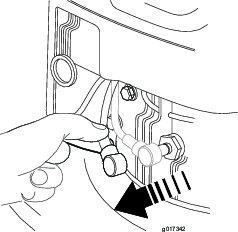
-
After performing the maintenance procedure(s), connect the spark-plug wire to the spark plug.
Replacing the Air Cleaner
| Maintenance Service Interval | Maintenance Procedure |
|---|---|
| Yearly |
|
-
Press down on the latch tabs on top of the air-cleaner cover (Figure 20).
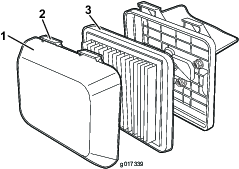
-
Open the cover.
-
Remove the filter (Figure 20).
-
Inspect the filter, and replace it if it is damaged or excessively dirty.
-
Inspect the paper air filter.
-
If the filter is damaged or is wet with oil or fuel, replace it.
-
If the filter is dirty, tap it on a hard surface several times or blow compressed air less than 207 kPa (30 psi) through the side of the filter that faces the engine.
Note: Do not brush the dirt off the filter; brushing forces dirt into the fibers.
-
-
Remove dirt from the air cleaner body and cover using a moist rag. Do not wipe dirt into the air duct.
-
Insert the filter into the air cleaner.
-
Install the cover.
Changing the Engine Oil
| Maintenance Service Interval | Maintenance Procedure |
|---|---|
| After the first 5 hours |
|
| Yearly |
|
-
Run the engine a few minutes before changing the oil to warm it.
Note: Warm oil flows better and carries more contaminants.
-
Ensure that the fuel tank contains little or no fuel so that the fuel does not leak when you tip the machine onto its side.
-
Disconnect the wire from the spark plug. Refer to Preparing for Maintenance.
-
Remove the dipstick.
-
Tip the machine onto its side, with the dipstick down, to drain the used oil out through the oil-fill tube.
-
Return the machine to the operating position.
-
Slowly pour oil into the oil-fill hole, wait 3 minutes, and check the oil level on the dipstick by wiping the dipstick clean and then inserting, but not screwing in, the oil-fill cap into the hole.
Note: Max. fill: 0.59 L (20 fl oz), type: Multigrade Mineral 10W-30 oil with an API service classification of SF, SG, SH, SJ, SL, or higher.
Note: Fill the engine crankcase with oil until the dipstick indicates that the engine-oil level is correct as shown in (Figure 21). If you overfill the engine with oil, remove the excess oil as directed in 5.

-
Install the dipstick and hand tighten it securely.
-
Dispose of the used oil properly at a local recycling center.
Servicing the Spark Plug
| Maintenance Service Interval | Maintenance Procedure |
|---|---|
| Every 100 hours |
|
Check the spark plug after every 100 operating hours. Use an Champion RN9YC spark plug or equivalent.
-
Shut off the engine and wait for all moving parts to stop.
-
Disconnect the wire from the spark plug.
-
Clean around the spark plug.
-
Remove the spark plug from the cylinder head.
Important: Replace a cracked, fouled, or dirty spark plug. Do not clean the electrodes because grit entering the cylinder can damage the engine.
-
Set the gap on the plug to 0.76 mm (0.030 inch) (Figure 22).
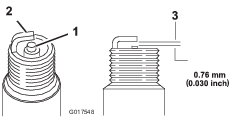
-
Install the spark plug and the gasket seal.
-
Torque the plug to 20 N∙m (15 ft-lb).
-
Connect the wire to the spark plug.
Replacing the Cutting Line
| Maintenance Service Interval | Maintenance Procedure |
|---|---|
| Yearly |
|
Important: You will need a torque wrench to install the cutting disc assembly properly. If you do not have a torque wrench or are uncomfortable performing this procedure, contact an Authorized Service Dealer.
Examine the cutting disc assembly whenever you run out of fuel. If the cutting disc assembly is damaged, replace it immediately.
-
Disconnect the spark plug wire from the spark plug. Refer to Preparing for Maintenance.
-
Tip the machine onto its side, with the dipstick down.
-
Remove the cutting disc by turning the retaining bolt counterclockwise (Figure 23), saving all the mounting hardware.

-
Replace the existing cutting lines with 2 equal lengths of new cutting line opposite of each other.
-
Install the cutting disc by turning the bolt clockwise (Figure 23), and installing all the mounting hardware.
-
Use a torque wrench to tighten the retaining bolt to 25 N∙m (18 ft-lb).
Important: A bolt torqued to 25 N∙m (18 ft-lb) is very tight. While holding the cutting disc with your gloved hand, put your weight behind the ratchet or wrench and tighten the bolt securely. This bolt is very difficult to overtighten.
Cleaning the Machine
| Maintenance Service Interval | Maintenance Procedure |
|---|---|
| Before each use or daily |
|
| After each use |
|
Warning
The machine may dislodge material from under the machine housing.
-
Wear eye protection.
-
Stay in the operating position (behind the handle).
-
Do not allow bystanders in the area.
-
Tip the machine on its side, with the dipstick down.
-
Use a brush or compressed air to remove grass and debris from the exhaust guard, the top cowl, and the surrounding deck areas.
Storage
Store the machine in a cool, clean, dry place.
Preparing the Machine for Storage
Warning
Fuel vapors can explode.
-
Do not store fuel more than 30 days.
-
Do not store the machine in an enclosure near an open flame.
-
Allow the engine to cool before storing it.
-
On the last refueling of the year, add fuel stabilizer to the fuel as directed by the engine manufacturer.
-
Run the machine until the engine shuts off from running out of fuel.
-
Prime the engine and start it again.
-
Allow the engine to run until it shuts off. When you can no longer start the engine, it is sufficiently dry.
-
Disconnect the wire from the spark plug.
-
Remove the spark plug, add 30 ml (1 fl oz) of oil through the spark-plug hole, and pull the starter rope slowly several times to distribute oil throughout the cylinder to prevent cylinder corrosion during the off-season.
-
Install the spark plug and tighten it with a torque wrench to 20 N∙m (15 ft-lb).
-
Tighten all nuts, bolts, and screws.
Troubleshooting
| Problem | Possible Cause | Corrective Action |
|---|---|---|
| The engine does not start |
|
|
| The engine starts hard or loses power |
|
|
| The engine runs rough |
|
|
| The machine or engine vibrates excessively |
|
|
| There is an uneven cutting pattern |
|
|
